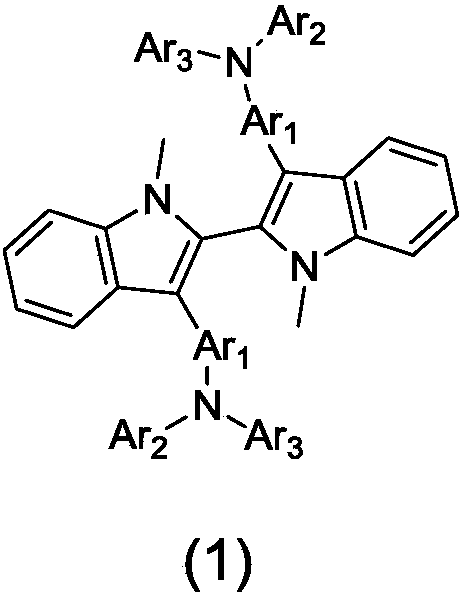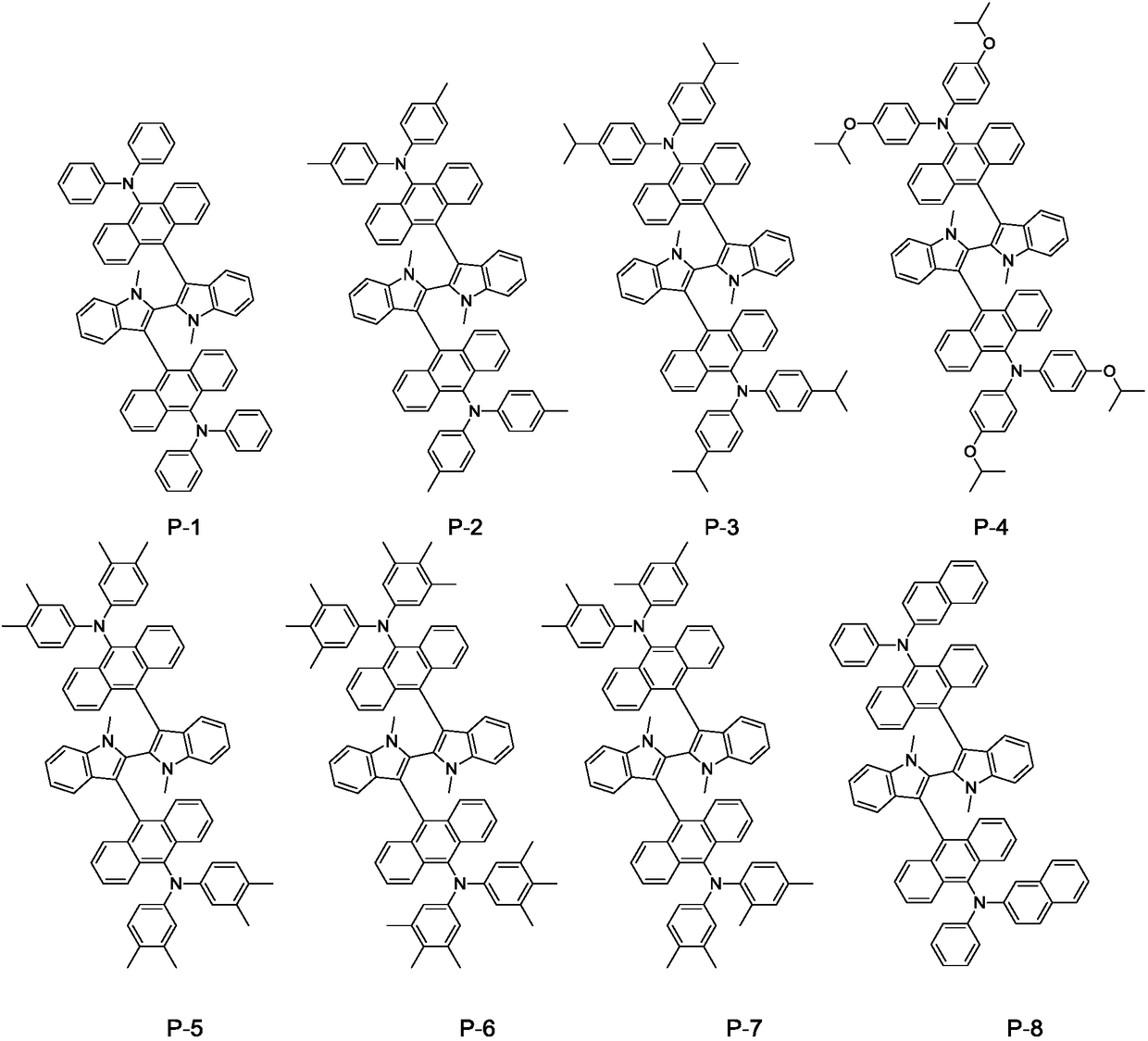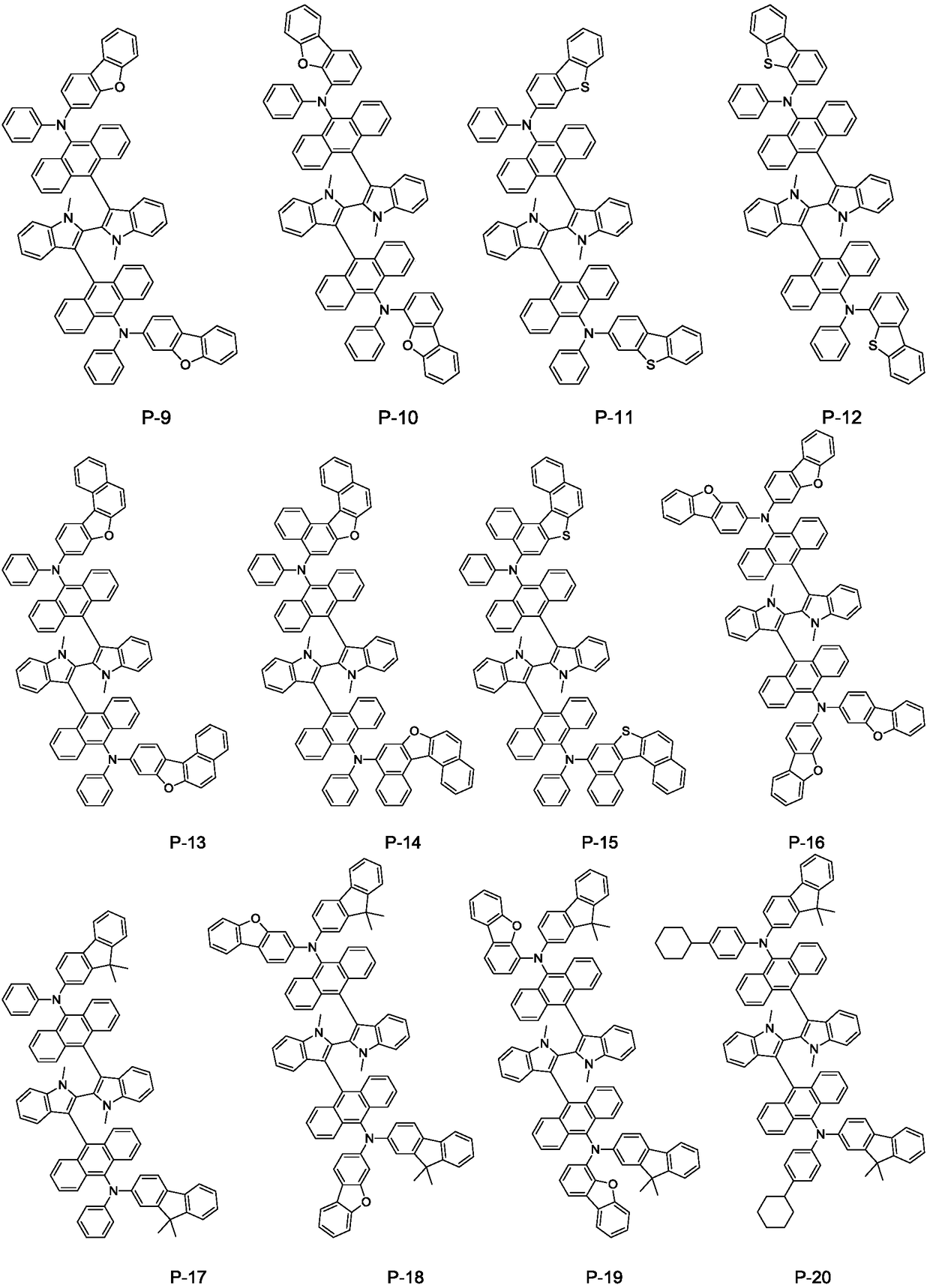Biindolyl material, organic electroluminescent device and display device
An electroluminescent and electromechanical technology, applied in the field of organic electroluminescent devices, display devices, and biindole materials, can solve the problems of low utilization rate, high technical content, high thermal stability requirements, etc. The effect of improving luminous efficiency
- Summary
- Abstract
- Description
- Claims
- Application Information
AI Technical Summary
Problems solved by technology
Method used
Image
Examples
Embodiment 1
[0039] The synthesis of embodiment 1 compound P-1:
[0040]
[0041]
[0042] Synthesis of intermediate M-1:
[0043] In a 1000 ml three-necked flask, under nitrogen protection, add 500 ml of tetrahydrofuran, 41.8 g (0.1 mol) of 3,3'-dibromo-1,1'-dimethyl-1H,1'H-2,2 '-Bindole, lower the temperature to -78°C, slowly add 137.5ml (0.22mol) 1.6mol / L n-butyllithium n-hexane solution dropwise, keep at -70~-80°C for 30 minutes, add 47.28 Gram (0.24mol) trimethyl borate, then slowly rise to room temperature, stir for 2 hours, add ammonium chloride solution for hydrolysis, separate the layers, concentrate the organic layer to dryness, recrystallize from ethyl acetate and ethanol mixed solvent to obtain the formula M- The 1,1'-dimethyl-1H,1'H-[2,2'-biindole]-3,3'-diboronic acid shown in 1 was 28.6 grams, and the yield was 82.18%.
[0044] The product shown in the obtained formula M-1 has been carried out nuclear magnetic detection, and the obtained nuclear magnetic analysis data...
Embodiment 2
[0054] Embodiment 2 Synthesis of some compounds of the present invention
[0055] Referring to the synthetic method of compound P-1, only in the preparation process of the second step M-02, 9-bromo-10-chloroanthracene is replaced by the corresponding In the synthesis of the third step P-1, the diphenylamine is replaced by the corresponding for specific reactions The list of mass spectra of the synthesized compounds is as follows:
[0056]
[0057]
[0058]
[0059] The 1-bromo-6-chloropyrene used was purchased from Bailingwei Technology Co., Ltd.
[0060] According to another aspect of the present invention, an organic electroluminescent device is provided, the hole transport material and / or the dye of the organic electroluminescent device is the biindole material according to the present invention.
[0061] The typical structure of an organic electroluminescent device is: substrate / anode / hole injection layer / hole transport layer (HTL) / organic light-emitting lay...
Embodiment 3
[0074] The compound of the present invention is used as the hole transport material in the organic electroluminescent device, and as a comparative organic electroluminescent device, the hole transport material is NPB.
[0075] The structure of the organic electroluminescence device is: ITO / HIL02 (100nm) / HTL (40nm) / EM1 (30nm) / ETL (20nm) / LiF (0.5nm) / Al (150nm).
[0076] In the production of the organic electroluminescent device in this embodiment, a glass substrate is selected, ITO is used as the anode material, HIL02 is used as the hole injection layer, EM1 is used as the main material of the organic light-emitting layer, TAZ is used as the electron transport layer material, and LiF / Al is used as the electron injection layer. layer / cathode material.
[0077] The preparation process of the organic electroluminescent device in this embodiment is as follows:
[0078] The glass substrate coated with the ITO transparent conductive layer (as the anode) is ultrasonically treated in a...
PUM
 Login to View More
Login to View More Abstract
Description
Claims
Application Information
 Login to View More
Login to View More - R&D Engineer
- R&D Manager
- IP Professional
- Industry Leading Data Capabilities
- Powerful AI technology
- Patent DNA Extraction
Browse by: Latest US Patents, China's latest patents, Technical Efficacy Thesaurus, Application Domain, Technology Topic, Popular Technical Reports.
© 2024 PatSnap. All rights reserved.Legal|Privacy policy|Modern Slavery Act Transparency Statement|Sitemap|About US| Contact US: help@patsnap.com










